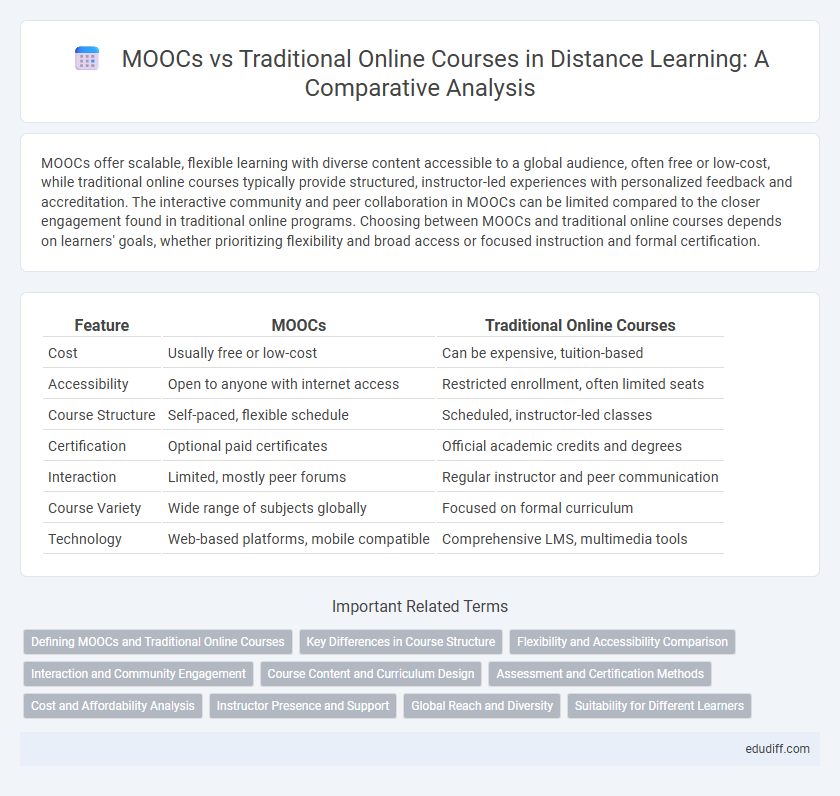MOOCs offer scalable, flexible learning with diverse content accessible to a global audience, often free or low-cost, while traditional online courses typically provide structured, instructor-led experiences with personalized feedback and accreditation. The interactive community and peer collaboration in MOOCs can be limited compared to the closer engagement found in traditional online programs. Choosing between MOOCs and traditional online courses depends on learners' goals, whether prioritizing flexibility and broad access or focused instruction and formal certification.
Table of Comparison
| Feature | MOOCs | Traditional Online Courses |
|---|---|---|
| Cost | Usually free or low-cost | Can be expensive, tuition-based |
| Accessibility | Open to anyone with internet access | Restricted enrollment, often limited seats |
| Course Structure | Self-paced, flexible schedule | Scheduled, instructor-led classes |
| Certification | Optional paid certificates | Official academic credits and degrees |
| Interaction | Limited, mostly peer forums | Regular instructor and peer communication |
| Course Variety | Wide range of subjects globally | Focused on formal curriculum |
| Technology | Web-based platforms, mobile compatible | Comprehensive LMS, multimedia tools |
Defining MOOCs and Traditional Online Courses
Massive Open Online Courses (MOOCs) are free or low-cost online classes designed for unlimited participation and open access via the internet, often offered by universities or institutions worldwide. Traditional online courses typically require enrollment through an educational institution, offer structured schedules, and may include tuition fees and limited class sizes. Both formats utilize digital platforms but differ in accessibility, cost, and scalability, catering to diverse learner needs in distance education.
Key Differences in Course Structure
MOOCs (Massive Open Online Courses) typically offer self-paced learning with a flexible, modular structure accessible to thousands of participants globally. In contrast, traditional online courses often follow a fixed schedule with structured deadlines, smaller class sizes, and more personalized instructor interaction. The scalability and open enrollment of MOOCs create a broad reach, while traditional courses emphasize deeper engagement and tailored feedback.
Flexibility and Accessibility Comparison
MOOCs offer unparalleled flexibility by allowing learners to access course materials anytime and anywhere, without fixed schedules, unlike traditional online courses that often follow a set timeline. The accessibility of MOOCs is enhanced by their open enrollment policies and free or low-cost options, making quality education available to a global audience. In contrast, traditional online courses may require prerequisites or paid enrollment, limiting accessibility compared to the broad reach of MOOCs.
Interaction and Community Engagement
MOOCs often struggle with fostering meaningful interaction and community engagement due to their massive scale and diverse student base, limiting personalized feedback and peer collaboration. Traditional online courses typically offer smaller class sizes, enabling structured discussions, real-time interactions, and stronger connections among participants. Enhanced community engagement in traditional online settings supports higher student retention and improved learning outcomes compared to the generally impersonal experience of MOOCs.
Course Content and Curriculum Design
MOOCs often feature standardized course content designed by leading universities, incorporating diverse multimedia resources and interactive elements to enhance learner engagement. Traditional online courses typically offer more tailored curriculum design, enabling instructors to adapt materials based on student feedback and course objectives for deeper subject mastery. Both formats leverage digital platforms, but MOOCs prioritize scalability, while traditional online courses emphasize customization and continuous content refinement.
Assessment and Certification Methods
MOOCs primarily utilize automated quizzes, peer assessments, and project-based evaluations to provide scalable and frequent feedback, while traditional online courses often incorporate proctored exams and instructor-graded assignments for rigorous assessment. Certification in MOOCs is typically offered through digital badges or certificates of completion, emphasizing accessibility and skill recognition rather than formal accreditation. Traditional online courses provide accredited certificates or diplomas, aligning closely with institutional standards and professional qualifications.
Cost and Affordability Analysis
MOOCs typically offer a cost-effective alternative to traditional online courses, often providing free access or minimal fees, reducing financial barriers for learners globally. Traditional online courses generally require higher tuition fees and additional costs such as textbooks or software licenses, making them less affordable for many students. Analyzing cost structures reveals MOOCs enhance accessibility by lowering expenses without compromising the availability of quality educational content.
Instructor Presence and Support
MOOCs often offer limited instructor presence due to large class sizes, relying heavily on automated feedback and peer interaction for student support. Traditional online courses provide more personalized instructor engagement through regular live sessions, direct communication, and tailored feedback, enhancing learner motivation and comprehension. Increased instructor presence in traditional online education correlates with higher student satisfaction and improved academic outcomes.
Global Reach and Diversity
MOOCs (Massive Open Online Courses) offer unparalleled global reach by providing access to thousands of courses from prestigious institutions to millions of learners worldwide, fostering diverse cultural interactions and inclusive learning environments. Traditional online courses, often limited to enrolled students within specific universities or programs, typically have narrower geographic and demographic scopes, reducing exposure to global perspectives. The scalability of MOOCs enables learners from varied socioeconomic backgrounds and countries to engage in education, enhancing cross-cultural understanding and collaboration.
Suitability for Different Learners
MOOCs offer flexibility and accessibility, making them ideal for self-motivated learners and those seeking diverse subjects without enrollment constraints. Traditional online courses provide structured schedules and personalized instructor interactions, benefiting learners who thrive with routine and direct support. Suitability depends on individual learning preferences, goals, and need for academic guidance.
MOOCs vs Traditional online courses Infographic

 edudiff.com
edudiff.com